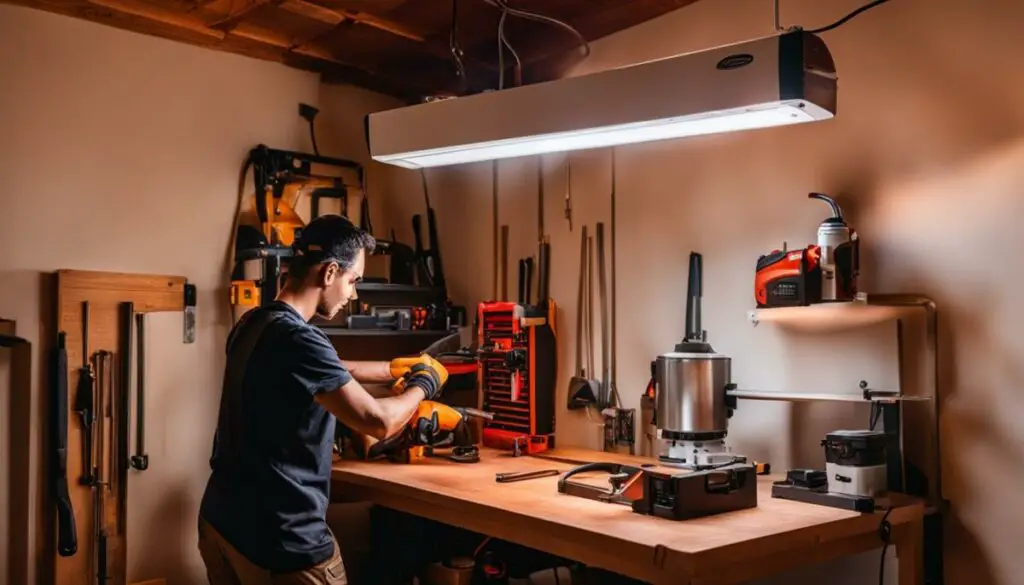Last Updated on 6 months by Francis
As the colder months approach, many homeowners are searching for cost-effective and energy-efficient heating solutions to keep their homes warm. Infrared heaters have become increasingly popular due to their superior energy efficiency and individual heating capabilities.
If you’re considering infrared heaters for your home, you may have some questions about their effectiveness in heating a house. In this section, we’ll explore whether infrared heaters can efficiently heat a house and provide you with a comprehensive guide to using infrared heaters as a heating solution for your home.
Contents
Key Takeaways
- Infrared heaters are a popular option for energy-efficient home heating.
- Many homeowners wonder if infrared heaters can effectively heat an entire house.
- In this section, we’ll explore the basics of infrared heating technology and its potential benefits for home heating solutions.
Understanding Infrared Heating Technology

Before we explore how infrared heaters can heat a house, let’s take a closer look at the technology behind it. Infrared heating technology works by emitting electromagnetic radiation from the heater to heat objects and surfaces in a room, rather than heating the air. This form of heating is similar to the way the sun warms the earth.
The heat generated by an infrared heater is produced by the radiation of infrared waves. These waves are longer than visible light but shorter than radio waves, with a wavelength ranging from 780 nanometers to 1 millimeter. The waves are absorbed by the objects they come into contact with, causing them to vibrate and generate heat.
Heating with Infrared Heaters
Infrared heating technology is becoming increasingly popular as a way to heat homes, and for good reason. Compared to traditional heating systems, infrared heaters offer several benefits, including:
- Energy efficiency: Infrared heaters only heat the objects and surfaces in a room, rather than wasting energy on heating the air, making them more efficient.
- Environmentally friendly: Since infrared heaters don’t rely on fuel or produce emissions, they are a more environmentally friendly choice for home heating.
- Cost savings: Because of their energy efficiency, infrared heaters can lead to cost savings on heating bills compared to other heating methods.
Another advantage of infrared heaters is that they are silent and don’t circulate air, making them ideal for individuals with allergies or respiratory issues.
Now that you have a better understanding of the technology behind infrared heaters, let’s dive into how they can effectively heat a house in the next section.
How Do Infrared Heaters Heat a House?

Infrared heaters work by emitting infrared radiation, a type of electromagnetic radiation that is invisible to the naked eye but can be felt as heat. Unlike traditional heating systems that rely on forced hot air or steam radiators, infrared heaters heat objects and surfaces directly, rather than heating the air around them.
When an infrared heater is turned on, it emits infrared radiation that travels in straight lines until it encounters an object or surface. When the radiation hits an object or surface, it is absorbed and then re-emitted as heat. This process continues until the heat is evenly distributed throughout the room, providing a comfortable and consistent warmth.
Infrared heat has a longer wavelength than visible light, which allows it to penetrate solid objects more deeply. This means that infrared heaters can heat objects and surfaces, such as walls, floors, and furniture, which then radiate heat back into the room. This process creates a gentle, comfortable warmth without the dryness or stuffiness of traditional heating systems.
| Advantages of Infrared Heating | Disadvantages of Traditional Heating |
|---|---|
| Provides consistent, even warmth throughout a room | Forced hot air can cause dryness and irritation |
| Energy efficient, with potential cost savings compared to other heating methods | Steam radiators can be noisy and take up space |
| Can be used as a supplemental heating source in specific areas or rooms | Central heating systems can be expensive to install and maintain |
The advantages of infrared heating over traditional heating systems are clear. Infrared heaters provide consistent warmth without the negative side effects of forced hot air or steam radiators. They are also energy efficient and cost-effective, making them a great choice for homeowners looking to reduce their energy bills.
However, it’s important to note that infrared heaters may not be the best option for every home or every situation. In large, open spaces or extremely cold climates, additional heating sources may be necessary to supplement the warmth provided by infrared heaters. It’s also important to properly size and place infrared heaters to ensure maximum efficiency and effectiveness.
Benefits of Infrared Heaters for Home Heating

Switching to infrared heaters as a home heating option can provide various benefits for homeowners. In this section, we will explore the advantages of using infrared heaters and why they may be a suitable option for your home.
Energy Efficiency
One of the significant benefits of using infrared heaters for home heating is their energy efficiency. Unlike traditional heating systems that heat the air, infrared heaters directly warm up objects and surfaces in a room. This method of heating reduces energy waste since no energy is expended heating the air. As a result, infrared heaters are more cost-effective, and homeowners can expect to see substantial savings on their energy bills.
Environmental Friendliness
Infrared heaters are environmentally friendly since they do not release any harmful pollutants or emissions into the atmosphere. They operate without the need for oil, gas, or other fossil fuels, making them a sustainable option for home heating.
Low Maintenance
Infrared heaters are low maintenance compared to other home heating options. They do not require regular maintenance, and the parts are durable and long-lasting. Most manufacturers provide warranties for infrared heaters, so you can be sure that you will be covered if anything goes wrong.
Cost Savings
Using infrared heaters for home heating can lead to significant cost savings in the long run. They consume less energy than traditional heating systems, resulting in lower energy bills. In addition, infrared heaters have a lifespan of up to 25 years, which means homeowners won’t have to replace them frequently, saving on replacement costs.
“Infrared heaters provide a cost-effective and eco-friendly heating solution, which is perfect for homeowners who are looking to save on energy bills and reduce their carbon footprint.”
As we can see, there are several benefits to using infrared heaters for home heating. They are energy-efficient, environmentally friendly, low maintenance, and can lead to significant cost savings. In the next section, we will explore the factors that homeowners should consider before deciding on infrared heating as their preferred heating option.
Factors to Consider Before Choosing Infrared Heating

Before deciding on using infrared heaters as your home heating solution, it’s essential to consider various factors that may affect their effectiveness.
One of the primary factors to consider is the size of your home. Infrared heaters are ideal for heating smaller rooms or specific areas of a house. If you have a larger house or open-concept living spaces, infrared heaters may not be the most suitable option for heating your home entirely.
Another consideration is insulation. Proper insulation is critical for energy-efficient home heating. If your home lacks adequate insulation, you may need to invest in additional insulation to maximize the efficiency of infrared heaters.
Additionally, you should evaluate your home’s overall heating needs. If you live in a cold climate, you may need a more robust heating solution. Infrared heaters can still be used as part of your home heating plan, but they may be more effective as supplemental heating sources.
When comparing heating solutions, consider the cost-effectiveness of infrared heaters. While the initial cost may be higher than some other options, infrared heaters can save you money in the long run due to their energy efficiency.
Overall, before choosing infrared heaters as your home heating solution, evaluate your home’s specific needs and consider the factors outlined above.
How to Properly Size Infrared Heaters for Your Home

Choosing the right size of infrared heater is crucial in ensuring optimal heating efficiency for your house. The size of the room, insulation, and other factors must be considered before making a decision. Here are some tips on how to size infrared heaters for your home:
- Calculate the wattage needed: The wattage required to heat a room depends on the size of the room and the desired temperature. As a general rule, you will need 10 watts of heating power per square foot of space to be heated. So, for a room that is 200 square feet, you will need a 2000-watt heater.
- Consider the insulation: If your house has good insulation, you may not need as much wattage to heat a room. On the other hand, if your house is poorly insulated, you may need more wattage to compensate for the heat loss.
- Choose the type of infrared heater: Different types of infrared heaters have different heating capacities. For example, a quartz infrared heater can produce more heat than a ceramic infrared heater. Consider the type of infrared heater to ensure it meets the needs of the room.
- Consider zoning: If you plan to use infrared heaters in different areas of your house, consider zoning. Zoning allows you to control the temperature in different areas of the house separately. This means you can adjust the wattage based on the needs of the specific zone.
By following these guidelines, you can ensure that you choose the correct size of infrared heater for your home heating needs.
It’s important to note that while infrared heaters can effectively heat a house, it’s essential to choose the right size of the heater to ensure optimal heating performance. A heater that is too small may not heat the room adequately, while a heater that is too large may lead to energy wastage and higher heating costs.
Installing and Maintaining Infrared Heaters

Installing infrared heaters is a fairly easy process, but it’s important to follow the manufacturer’s instructions carefully to ensure the best results. Here are some general tips to keep in mind:
- Choose the right location: Infrared heaters should be installed in a location where they can provide the most direct heat to the desired area. This may be on the ceiling, on a wall, or on a stand, depending on your specific needs.
- Ensure proper clearance: Infrared heaters need to have adequate clearance around them to prevent any fire hazards. Make sure to follow the manufacturer’s recommendations for clearance distances.
- Use the right voltage: Make sure the infrared heater is compatible with your home’s electrical system. Using the wrong voltage can damage the heater or create a fire risk.
- Regular maintenance: Infrared heaters don’t require much maintenance, but it’s important to clean them regularly to ensure optimal performance. Simply wipe down the surface of the heater with a soft cloth to remove any dust or debris.
Following these tips can help ensure that your infrared heater functions properly and efficiently for years to come.
Comparing Infrared Heaters to Other Heating Options

When it comes to home heating options, homeowners have plenty of choices. One of the most popular options in recent years has been infrared heaters. However, it’s important to compare infrared heaters to other heating options to determine which one is the best fit for your specific needs.
Central Heating Systems
Central heating systems are a common way to heat homes, especially in colder climates. These systems use a central furnace or boiler to provide heat through ducts or pipes throughout the house.
While central heating systems are effective at heating large areas and can be controlled with a thermostat, they can also be expensive to install and maintain. They also tend to use a lot of energy, which results in higher utility bills.
Electric Heaters
Electric heaters come in different types and sizes, such as space heaters or baseboard heaters. These heaters are often inexpensive and easy to use, making them a popular choice for homeowners.
However, electric heaters can be costly to operate over time, especially if used frequently or for extended periods. They also tend to heat up small areas rather than large rooms, which may not be useful for homeowners looking to heat their entire house.
Radiant Floor Heating
Radiant floor heating is a heating system that involves placing heating coils or tubes directly into the floor of a house. The heat radiates upward, providing warmth throughout the room.
While radiant floor heating can be an effective way to heat a house, it can also be an expensive installation process. It’s also not always practical for homeowners who are renovating their homes or who don’t want to rip up their existing floors to install the heating system.
Infrared Heaters
Infrared heaters offer a number of benefits compared to other home heating options. They’re energy-efficient, environmentally friendly, and can save homeowners money on their utility bills. They also provide targeted heating, meaning they can be used to heat specific areas or rooms in a house rather than heating the entire house.
While infrared heaters may not be suitable for extremely cold climates or large, open spaces, they can be a great option for homeowners looking for an energy-efficient and cost-effective heating solution.
Using Infrared Heaters as Supplemental Heating
One of the benefits of infrared heaters is their versatility, allowing homeowners to use them as supplemental heating sources. While infrared heaters can be effective at heating an entire room or area, they can also provide additional warmth in specific locations where central heating may not reach or where extra heat is needed, such as a home office or a chilly corner of a basement.
When using infrared heaters as supplemental heating, it’s important to consider the size of the room or area and the specific heating needs of that space. An infrared panel heater mounted on a wall can provide targeted heat for a small room or home office, while a portable infrared space heater can be moved from room to room as needed.
It’s also essential to consider safety when using infrared heaters as supplemental heating. Avoid placing the heater near flammable objects or materials, and make sure to follow the manufacturer’s instructions for safe operation.
Benefits of Using Infrared Heaters as Supplemental Heating
There are several benefits to using infrared heaters as supplemental heating sources:
- Cost-effective: Using infrared heaters as supplemental heating can be more cost-effective than relying on a central heating system to heat an entire house. By only heating the areas that need it, homeowners can save on energy costs.
- Energy-efficient: Infrared heaters use less energy than traditional heating methods, making them an energy-efficient choice for supplemental heat. They also produce heat quickly, reducing the amount of time the heater needs to be in use.
- Easy to Use: Portable infrared heaters require minimal setup and can be easily moved from room to room. Wall-mounted infrared panel heaters are also easy to install.
Factors to Consider When Using Infrared Heaters as Supplemental Heating
Before using infrared heaters as supplemental heating sources, homeowners should consider:
- The size of the area to be heated
- The specific heating needs of that space
- The safety considerations of using a heater in that location
Overall, using infrared heaters as supplemental heating sources can be an effective and energy-efficient way to provide warmth to specific areas or rooms in a home. By taking the necessary safety precautions and considering the specific heating needs of each space, homeowners can maximize the benefits of infrared heaters for their home heating options.
Understanding the Limitations of Infrared Heaters
While infrared heaters offer many benefits for home heating, they do have some limitations that homeowners should be aware of before choosing them as their primary heating solution.
One of the main limitations is that infrared heaters are best suited for heating small to medium-sized rooms, up to around 1,000 square feet. For larger homes, multiple infrared heaters would be needed, which may not be cost-effective or practical.
In addition, infrared heaters work best in spaces with good insulation. If a room is poorly insulated, the heat produced by an infrared heater may escape too quickly, making it difficult to maintain a comfortable temperature.
Finally, while infrared heaters are energy-efficient, they may not be the most effective option for homes in extremely cold climates. Infrared heaters work by heating objects and surfaces in a room, rather than heating the air itself. In very cold temperatures, the air may need to be warmed more directly to achieve a comfortable temperature.
Overall, while infrared heaters can be an excellent home heating option for many households, homeowners should consider their specific needs and limitations before making a decision. In some cases, other heating solutions may be more suitable for their home.
Keywords: heating solutions, home heating options
Tips for Maximizing the Efficiency of Infrared Heaters
If you’ve decided to use infrared heaters as a home heating option, there are several tips you can follow to maximize their efficiency:
- Use a thermostat: Set a thermostat to maintain a consistent temperature in the room you’re heating. This will prevent the heater from working overtime and wasting energy.
- Place the heater strategically: Install the infrared heater in a location where it can efficiently heat the room. For example, place it in a corner or near a seating area where you spend the most time.
- Ensure proper insulation: Proper insulation can help trap heat in a room and prevent it from escaping. This will help the infrared heater work more efficiently and keep the room warmer for longer.
- Consider zone heating: Rather than heating your entire home with infrared heaters, consider using them for zone heating. This means heating only the rooms you use the most, rather than wasting energy on unoccupied spaces.
- Clean and maintain the heater: Regularly clean the infrared heater to remove dust and debris that can accumulate on the heating element. This will help maintain the heater’s efficiency and lifespan.
By following these tips, you can ensure that your infrared heaters are heating your home as efficiently and effectively as possible, providing you with a cozy and comfortable living space while also being an energy-efficient home heating option.
Conclusion
After exploring the science behind infrared heating technology, the mechanisms by which they heat a house, and the benefits of using them for home heating, we can confidently answer the question, “Can infrared heaters heat a house?” with a resounding yes.
Infrared heaters offer an energy-efficient and cost-effective heating solution with numerous benefits. However, before choosing infrared heaters, homeowners must consider factors such as the size of the house and insulation to ensure optimal heating efficiency.
Proper sizing and placement of infrared heaters are essential for achieving optimal heating performance. It is also crucial to install and maintain them correctly to ensure their longevity and efficient operation.
Although there are limitations to their effectiveness, infrared heaters can be used as supplemental heating sources to boost warmth in specific areas of a house.
By following practical tips on maximizing the efficiency of infrared heaters, homeowners can benefit from this heating solution’s energy efficiency and cost savings.
Overall, infrared heaters are an excellent heating solution for homeowners looking for an energy-efficient, cost-effective, and environmentally friendly heating method.
FAQ
Can infrared heaters effectively heat a house?
Yes, infrared heaters can effectively heat a house. They use infrared heating technology to provide warmth by emitting infrared radiation, which is absorbed by objects and surfaces in a room, thereby heating the surrounding air.
What is infrared heating technology?
Infrared heating technology utilizes the emission of infrared radiation to produce heat. Unlike traditional heating systems that rely on convection to warm the air, infrared heaters directly heat objects and surfaces, resulting in a more efficient and comfortable heating experience.
How do infrared heaters heat a house?
Infrared heaters heat a house by emitting infrared heat, which is a form of electromagnetic radiation. This heat is absorbed by objects and surfaces in the room, including furniture, walls, and even people, providing a direct and efficient source of warmth.
What are the benefits of using infrared heaters for home heating?
There are several benefits to using infrared heaters for home heating. They are energy-efficient, as they provide direct heat without the need to warm the entire volume of air in a room. Additionally, infrared heaters are environmentally friendly, as they operate without burning fossil fuels or producing harmful emissions. They can also potentially save on heating costs compared to other heating methods.
What factors should I consider before choosing infrared heating?
Before deciding on infrared heating, it’s important to consider several factors. The size of your house, insulation levels, and the specific heating needs of different areas should be taken into account. Additionally, it’s essential to ensure that you have sufficient electrical capacity to support the power requirements of infrared heaters.
How do I properly size infrared heaters for my home?
To properly size infrared heaters for your home, you should consider the size of the area you want to heat, ceiling height, insulation, and any other factors that may affect heat loss. There are calculations and guidelines available to help determine the appropriate wattage and number of heaters needed for optimal heating efficiency.
How do I install and maintain infrared heaters?
Installing infrared heaters typically involves mounting them on the wall or ceiling and connecting them to a power source. It’s essential to follow the manufacturer’s instructions and ensure proper electrical wiring. For maintenance, regularly clean the heaters to remove dust and debris that may affect their performance. Additionally, check for any loose connections or signs of wear and tear.
How do infrared heaters compare to other heating options?
Infrared heaters have several advantages compared to other heating options. They are more energy-efficient than central heating systems, as they provide direct heat to the objects and surfaces in a room. Additionally, they are often more cost-effective than electric heaters and can be used as a supplemental heating source in conjunction with radiant floor heating or other systems.
Can infrared heaters be used as supplemental heating?
Yes, infrared heaters can be used as supplemental heating sources. They are particularly useful for providing additional warmth in specific areas or rooms of a house that may require extra heating, such as bedrooms, bathrooms, or home offices.
What are the limitations of infrared heaters?
While infrared heaters are effective for most residential heating needs, they may not be the most suitable option in extremely cold climates or large, open spaces. In such cases, additional heating methods may be necessary to achieve the desired level of warmth.
What are some tips for maximizing the efficiency of infrared heaters?
To maximize the efficiency of infrared heaters, consider setting the thermostat at an appropriate temperature, placing the heaters in strategic locations for optimal heat distribution, and ensuring proper insulation in the room. This will help to ensure that the heaters provide efficient and effective heating performance.









